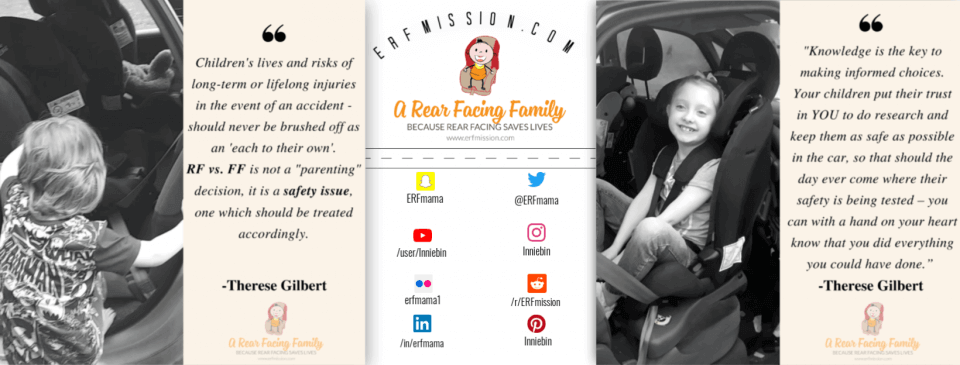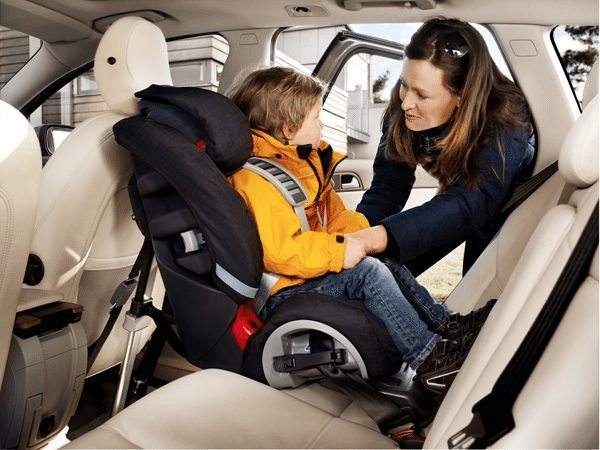** If you would like to do a guest post on my blog, please have a look at this post with the information and contact details. :) **
California recently updated its car seat laws, making it mandatory for children to remain rear-facing until their second birthday. The new rules don’t take effect for more than a year, so children who are lawfully forward-facing at one year-old now won’t have to be turned back around. Tighter legislations involving car and booster seats is being hashed out across the country, and for a good reason. The new laws keep kids safer in the event of a car accident, and can prevent personal injury or death. Even still, some parents balk at the new guidelines, with concerns over the cost of new restraints or the comfort of their children. Here’s a look at some of the misinformation that’s circulating, and clarification as to why certain laws and safety guidelines exist.

- Rear-Facing Seats are Unnecessary After the Child’s First Birthday
While California is only the third state to create laws that require kids under two to be forward-facing, the American Academy of Pediatrics has been recommending the practice for years. Studies have shown that kids under two are 75% less-likely to die in a collision if their car seat is rear-facing, so even in states where the requirement ends on the first birthday, it’s still much safer.
- Children Who are Large for their Age Should Face Forward
While the law varies from state to state on size-requirements, best practices don’t. Kids under two have disproportionately large heads compared to adults, and their muscles are also underdeveloped. In addition, they have more cartilage in their necks than adults. Over time, cartilage in the neck hardens into bone, but it doesn’t usually happen until a child is between the ages of four and six. For these reasons, younger children are at a higher risk for damaging, stretching, or tearing their spinal cords. While most states lift car seat restrictions when a child reaches a certain height or weight, it doesn’t necessarily mean that the child is developed enough to handle the forces of a crash while facing forward.
- Children in States with No Extended Rear-Facing Legislation Can Lawfully Face Forward at Age One
Interestingly, it can be illegal to have a child forward-facing after he reaches his first birthday, even if the law does not extend to the second birthday. This is because most of the state laws say that a car seat must be used properly, according to the manufacturer’s instructions. Several companies, including the popular brand Cosco, now include instructions that say their seats should not be used forward-facing until a child reaches the age of two.
- It’s Expensive to Keep Changing Out Car Seats as a Child Grows
There are car seats on the market today that will protect a child who weighs anywhere from 5 to 120 pounds, so parents only need to purchase one per child. Some parents prefer the carrier-style seat, which works well for infants, but it needs to be changed around a child’s first birthday. In these cases, only two seats must be purchased, but the price of both combined can be well under $100.
- Children are Happier and More Comfortable when they Face Forward
It used to be that parents would rejoice at their child’s first birthday, because it meant the car seat could be turned around. While it may make it easier to interact with or console a child who is forward-facing, it’s still a safety tradeoff. Parents of children who sustain serious injuries because they’re forward-facing would likely be glad to muddle through a few fussy moments to keep their child pain-free in the long run. Moreover, today’s seats are very comfortable, even when a child must fold or bend his legs to remain rear-facing.
- Manufacturers and Car Seat Laws Make it Difficult to Know which Seat to Use
Indeed, choosing the right car seat can seem daunting. There are dozens of brands to choose from, and each company puts out multiple styles. It can be tough to choose one, and to be sure that it complies with state regulations. The National Highway Traffic Safety Administration (NHTSA) has created an online tool that enables parents to choose the best seat for a child, depending on age and weight.
The right age to forward-face a child’s car seat is still highly-debated amongst parents. Some prefer to keep their children rear-facing for as long as a seat’s guidelines allow, which can be as late as five years-old. Others anxiously await the age at which it’s legal to turn a seat around, for personal reasons. Although legislation does not mandate that children must be rear-facing until age two in all cases, it remains the safest option in a collision.
Gabriel Levin a Personal Injury Lawyer based out of Philadelphia
Therese has completed the ‘Advanced Child Car Seat Training Course’ at TRL (Transport Research Lab) and is a CPD accredited car seat expert. She blogs about in-car safety, car seats, tips, reviews, giveaways and advice. She’s a mum on a mission to change the law and raise awareness. She is also a breastfeeding advocate and gentle parenting promoter who loves cloth nappies, baby-wearing, BLW and co-sleeping/bed-sharing.


